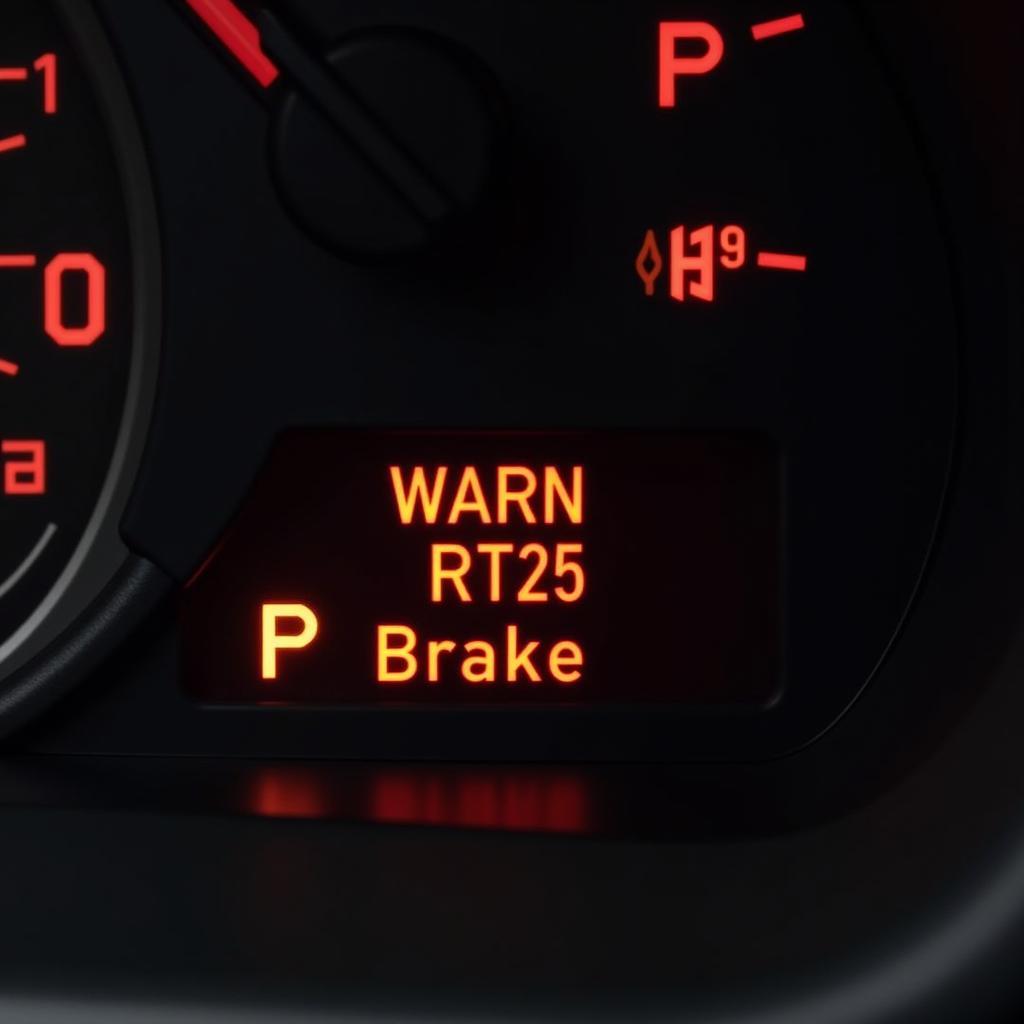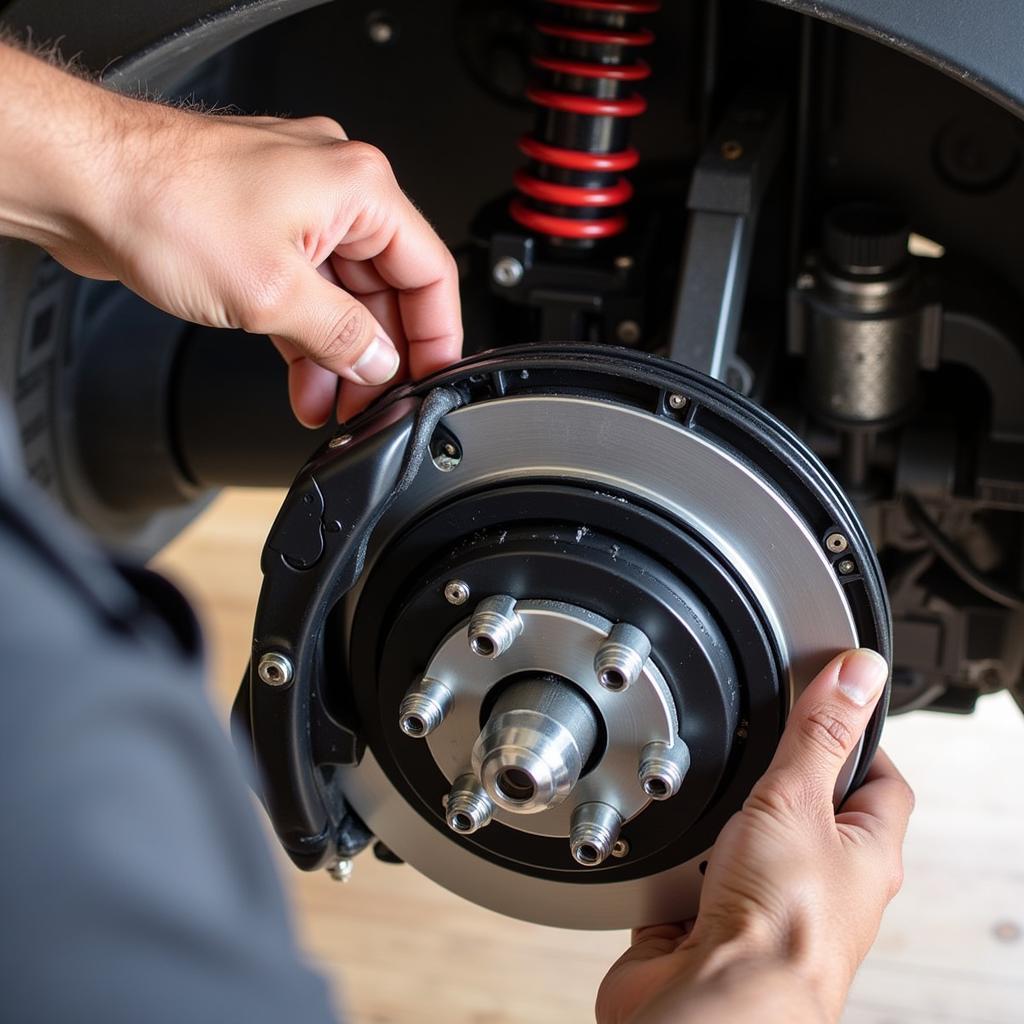The dreaded “WARN RT25 brake” message flashing on your dashboard can be a cause for concern. This warning signal, common in various off-road vehicles equipped with WARN winches, indicates a potential issue with the winch’s braking system. While it might seem daunting, understanding what triggers this warning and how to address it can save you from a potential headache on the trails.
 WARN RT25 Brake Warning Light Displayed on a Dashboard
WARN RT25 Brake Warning Light Displayed on a Dashboard
Decoding the WARN RT25 Brake Warning
The “WARN RT25 brake” message is essentially your winch’s way of communicating a problem with its built-in braking system. This system is crucial for holding the load securely when winching, especially on inclines. When the warning pops up, it signals that the brake might not be engaging correctly, potentially leading to uncontrolled unwinding of the winch drum – a situation that can be both dangerous and damaging.
Common Culprits Behind the Warning
Several factors can trigger the “WARN RT25 brake” warning, ranging from minor glitches to more significant mechanical issues. Let’s break down some of the most common culprits:
1. Electrical Gremlins
Like any electronically controlled system, the WARN RT25 brake system relies on seamless communication between various sensors and the control module. Loose connections, corroded terminals, or damaged wiring within this network can disrupt this communication, leading to a false warning signal.
2. Low Battery Voltage
A weak or dying battery is another frequent offender. The WARN RT25 brake system requires sufficient power to operate reliably. When the battery voltage drops below a certain threshold, it can interfere with the brake’s engagement, triggering the warning.
3. Brake Adjustment Issues
Over time, the brake mechanism within the winch can become misaligned or wear down, affecting its ability to engage properly. This misalignment can result from frequent use, heavy loads, or even improper installation.
4. Internal Component Failure
In some cases, the warning might point to a more serious problem, such as a malfunctioning solenoid or a damaged brake disc within the winch. These internal component failures typically necessitate professional diagnosis and repair.
 Close Inspection of the WARN RT25 Winch Brake System
Close Inspection of the WARN RT25 Winch Brake System
Troubleshooting the WARN RT25 Brake Warning
Before rushing to a mechanic, there are several troubleshooting steps you can take to identify and potentially resolve the “WARN RT25 brake” warning:
-
Check Your Battery: Begin by ensuring your vehicle’s battery is in good health and adequately charged. Connect a voltmeter to the battery terminals and check the voltage. A fully charged battery should read around 12.6 volts. If the voltage is significantly lower, charge the battery or consider replacing it.
-
Inspect Electrical Connections: Carefully examine all the electrical connections associated with your WARN RT25 winch, including the battery terminals, winch motor connections, and control pack wiring. Look for any signs of corrosion, loose connections, or damaged wires. Clean any corroded terminals and tighten any loose connections. If you find any damaged wires, replace them with the appropriate gauge wiring.
-
Inspect the Winch Brake: With the winch motor disconnected from the battery, manually disengage the clutch and attempt to freely spool the winch rope out. If you experience resistance, it indicates the brake is engaging. If not, the brake may require adjustment or further inspection.
“Remember, even if you’re comfortable with basic mechanics, it’s crucial to refer to your winch’s user manual for specific instructions on brake adjustment. Incorrect procedures can impact the winch’s performance and safety.” – Mark S., Senior Automotive Technician
-
Seek Professional Help: If the warning persists after these troubleshooting steps, it’s best to consult a qualified automotive technician specializing in winch systems. They have the expertise and diagnostic tools to pinpoint the root cause and recommend the appropriate course of action, whether it’s a complex repair or a simple component replacement.
 Professional Mechanic Diagnosing a Winch Issue Using Specialized Tools
Professional Mechanic Diagnosing a Winch Issue Using Specialized Tools
Maintaining Your WARN RT25 Brake System
Preventing future occurrences of the “WARN RT25 brake” warning largely comes down to regular maintenance and proper winch operation:
- Regular Inspection: Make it a habit to visually inspect your winch and its brake system regularly, especially after winching heavy loads or encountering harsh off-road conditions.
- Keep it Clean: Dirt, mud, and debris can wreak havoc on your winch’s moving parts, including the brake system. After each off-road adventure, clean your winch thoroughly, paying attention to the brake mechanism.
- Proper Winching Practices: Avoid shock loading the winch, as it can put excessive stress on the brake system. Always use the winch within its rated capacity and ensure the winch rope spools evenly onto the drum.
Conclusion
Encountering the “WARN RT25 brake” warning doesn’t have to be a cause for panic. By understanding the potential triggers and following the troubleshooting steps outlined above, you can often address the issue yourself. However, remember that safety should always be your top priority. If you’re unsure about any aspect of your winch’s operation or suspect a more serious problem, don’t hesitate to seek professional help from a qualified automotive technician. Regular maintenance and proper winching practices go a long way in ensuring your WARN RT25 winch continues to be a reliable companion on your off-road adventures.
